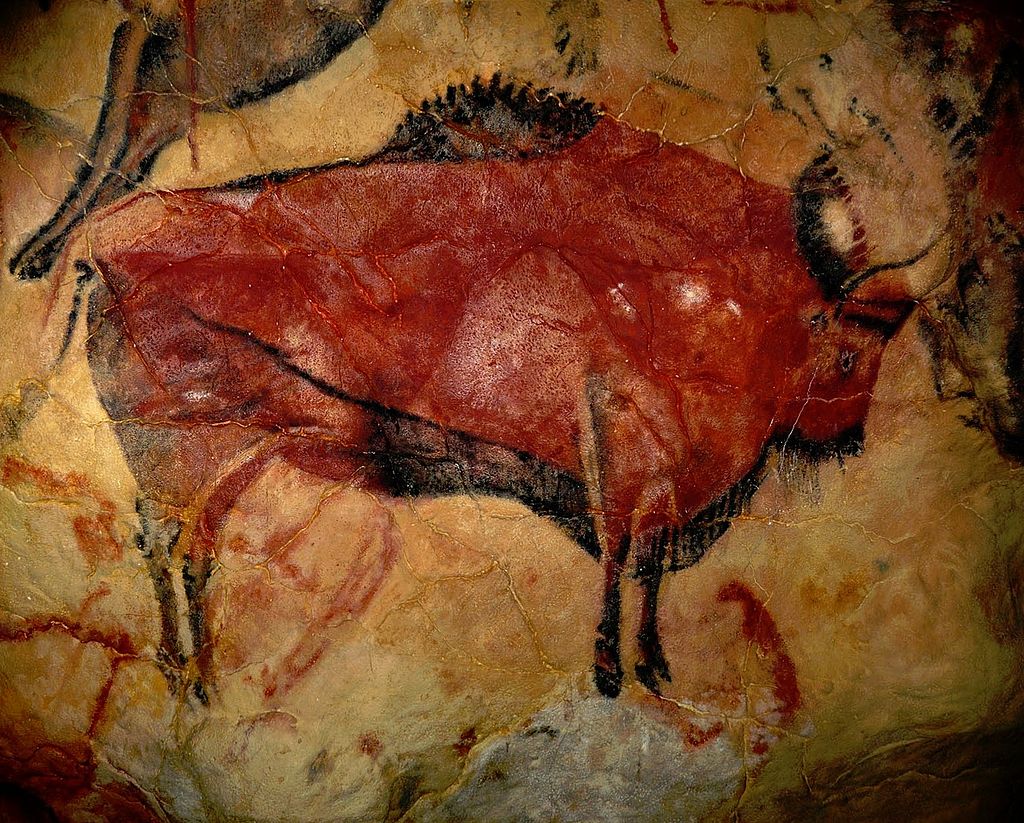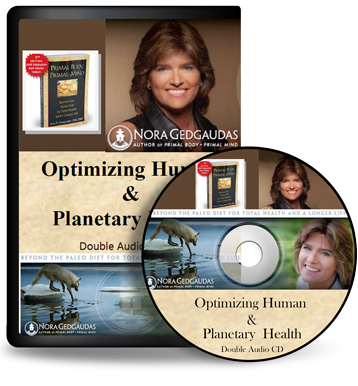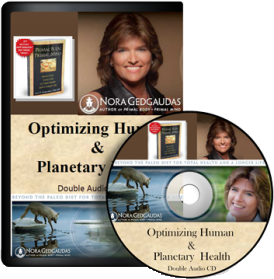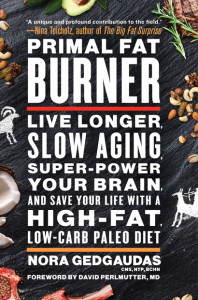What exactly is the Paleo diet, and how does it work? What is the theory behind it?
It is a way of eating that seeks to mimic foundational dietary principles followed by our ancestors throughout most of human evolution, spanning the last 2-3 million years. This is a diet that is the most familiar and natural for the human body, and seems to minimize susceptibility to modern day diseases and premature physical degeneration. It includes a variety of meats/fish (containing natural healthy fats) that are from animals naturally grass-fed, organic (seeing as once upon a time everything was essentially “organic”) fibrous vegetables/greens and occasional fruits, plus some nuts and seeds– in other words, it includes foods that would’ve looked like food to someone wandering around 40,000 years ago with a loincloth and a spear (or a pair of mukluks, as it were).
We lost stature, bone density, overall health, immune integrity, and even brain size once we adopted modern day agricultural foods. The idea consistent with a Paleolithic approach involves sticking to the dietary inclusions that would have served to shape our early physiological makeup and nutritional requirements and avoiding the modern day things that tend to compromise that. The agricultural revolution (and needless to say, the food industry) is exceedingly recent in human evolutionary terms and something to which we have not genetically adapted as a species. In fact the evidence seems to show that we are not becoming more adapted to many of these foods, we are actually becoming less adapted (as evidenced in part by the veritable explosion of gluten sensitivity, together with other growing sensitivities to proteins and lectins in other post agricultural foods). I talk more about why this is in my book, Primal Body, Primal Mind.
Will you lose weight on the Paleo diet?
It depends. If you happen to be overweight starting the Paleo diet then chances are you will be likely to lose most of the weight you need to. It is technically possible to overeat Paleolithic foods, like anything else– although it is less likely because it is more nutrient dense, more inherently satisfying to appetite and much lower in sugars and starches that tend to be most responsible for undesirable weight gain. If a person is underweight, this way of eating may possibly help normalize that (depending on the underlying cause). Again, “it depends”. The primary idea behind the Paleo diet is not so much focused on weight loss, but instead better optimization of overall health by consuming a diet to which humans are most naturally adapted. Usually normalization of weight follows this, but it’s far from the only reason people adopt this way of eating.
From this essential starting place other principles derived from modern-day science and human longevity research can be applied to better refine the basic Paleo dietary approach and better optimize outcomes in the face of our unique and unprecedented modern day challenges, as I explore in considerable depth in my book Primal Body, Primal Mind, but “Paleo” is really undeniably foundational for us all.
What foods are in, and what’s out?
A lot depends on how you actually define “Paleolithic”. If we’re talking about Paleo humans, say, 200,000 years ago (back to the time when we first became fully human) up to the edge of the pre-agricultural time period, then we’re talking about a variety of climatic conditions– some that were actually quite harsh– that would have limited us to a mostly meat and fat diet, with very little inclusion of anything resembling sugars or starches. If one is talking “Neo-Paleolithic”, following the more stable and temperate conditions following the end of the last Ice Age and the die off of the mega fauna, plus the more universal adoption of fire for cooking, then diets would’ve been more inclusive of leaner meat (though we certainly continued to seek out and covet high fat foods), a greater variety of plant-based foods, including some starchy roots/tubers and more fruit (in season).
What’s In?
Grass-fed meat, natural fats, mostly fibrous vegetables and greens, nuts and seeds (as long as they are well tolerated) and some seasonal fruit.
What’s Out?
Feedlot meat, pesticides, GMO’s, refined sugar and salt, fast food, and most other things that would not have been recognizable as food to pre-agricultural human populations. The Paleo diet tends to be essentially free of post agricultural foods including grains/gluten, legumes, dairy and processed modern day “food-like substances”.
In my view there is good reason– especially in modern times– to particularly avoid sugars and starches, and to moderate our protein intake, relying more on natural fat as a primary source of fuel (rather than glucose).
Although it is fashionable and populist to say “eat a varied diet” and “everything is fine as long as it’s real food” and the ever-popular, “everything is fine in moderation”, I think the current state of compromised health in the majority of us in today’s world requires a more careful and disciplined approach. It’s simply the nature of the times and highly compromised conditions we are in. There is a great deal of evidence and research today in the literature supporting the adoption of a more fat-based, ketogenic diet. This way of eating takes advantage of what is termed “the caloric restriction effect” (leading consistently to greater longevity) without leaving one hungry or malnourished, it minimizes the risk of metabolic issues, most common modern diseases–including minimizing the risk for developing cancer (while supporting immune health), and does the best possible job of supporting the brain and nervous system, cognitive functioning and healthy moods of any other dietary approach long term. Mind you, not all participants employing the Paleo approach do it this way, but the evidence is increasingly mounting for the inherent benefits of this particular modification to “Paleolithic dietary principles”. It also happens to be the single most affordable approach to this particular diet and lifestyle.
What does science say about the Paleo diet?
There are tens of thousands of peer-reviewed articles throughout many, many research journals over decades addressing various aspects of what can be defined as “the Paleolithic diet”.
Stable isotope evidence from researchers studying early human fossil remains certainly support the idea that meat eating plays—and has always played a central role in the human diet.
At the very least this presents conclusive evidence that we were never vegetarians and that animal source foods are something to which we are exceedingly well adapted as a species.
What “science is saying about all this” can also be broken down into virtually innumerable studies showing the benefits of avoiding processed foods, avoiding dietary pesticides, avoiding GMO’s, avoiding refined sugar and refined salt, avoiding gluten, consuming naturally grass fed (as opposed to feedlot) meats, consuming unprocessed, organic vegetables and greens. One can also find overwhelming evidence for the benefits of a fat-based, ketogenic diet for the treatment of Alzheimer’s, cancer, heart disease, autoimmunity, diabetes, metabolic disorders… along with all the research over the last few decades or more showing the inherent benefits of low and very low carbohydrate diets. We can also include all the evidence in the literature at-large showing support for the avoidance of processed foods and chemicals, GMO’s, pesticides, and modern day junk foods. When taken as a whole, the potential scientific evidence already published that supports a Paleolithic approach to eating is quite literally staggering.
Aside from weight loss, what are the Paleo diet’s health benefits?
The potential list is a long one. Quite literally all modern day disease processes and health concerns may potentially be powerfully and positively impacted by a well formulated Paleo diet.
There is substantial evidence supporting the use of Paleolithic dietary principles to help address things like heart disease, cancer, diabetes, autoimmune disease, cognitive impairment, mental illness and mood disorders, mental decline and premature aging. There is also ample evidence to support the use of a Paleolithic way of eating to support peak athletic performance, improved endocrine health, cognitive and mood enhancement, improved bone density and greatly improved energy/vitality.
Studies researching the health of existing primitive societies still consuming their native diets consistently showed these same sorts of benefits and a distinct lack of ill health of any kind in their populations.
What’s your best advice on following the Paleo diet on a budget?
The first thing I’ll do is refer everyone to an e-book titled: “Primal Tightwad” written by Carolyn Rush. Her findings in it basically show that the version of the Paleo diet that I recommend in my book, Primal Body, Primal Mind is actually the cheapest way of eating well currently possible. After comparing the costs associated with a weeks’ worth of meal menus based on the standard American diet to a weeks’ worth of meal menus based on a more fat-based, ketogenic approach that I talk about in my book showed that this “Primal” way of eating was not only cheaper– but literally $1,500 per person per year cheaper, on average. The idea that one must of necessity be wealthy in order to eat well is a total unnecessary myth.
By simply avoiding nutrient devoid, processed, chemically-laden junk food, sodas, sports drinks, so-called energy-boosting beverages, juices, cereals and other grain-based foods, conventional dairy products, desserts and conventional snack foods one can save untold thousands of dollars per year. When you consume a diet that is extremely nutrient dense, it is much easier to meet your nutritional requirements as well as satisfy your appetite on much less food.
This readily offsets the little bit extra one pays for top quality nourishment– not mentioning the untold savings in potential healthcare costs long-term.
Are there health risks to the Paleo diet, or people who should avoid it?
Those suffering serious illness should always consult with a knowledgeable and qualified healthcare provider familiar with their situation before undertaking some radical change in diet.
Even a positive change can be discombobulating temporarily to some and may require closer monitoring or special modifications to the transition for greater comfort and ease. Also, anyone with gallstones or who may be prone to these and/or biliary attacks needs to get to the bottom of and resolve these issues before engaging in a dietary approach higher in even extremely healthy natural fats.
Otherwise, it is the most natural approach to eating in human history.
Please share your favorite Paleo meal and snack ideas.
My meals are usually pretty simple. I’ll have a duck egg in the morning cooked in a little duck fat, or a maybe couple of ounces of grass fed ground beef sautéed together with mushrooms, onions, and a variety of chopped vegetables and greens as a sort of breakfast stir fry. Evening leftovers or even light snacks can also be a morning favorite.
Lunch might be a vegetable salad with a small amount of sliced meat, plus maybe some avocado with an olive oil/balsamic/raw cider vinegar combo for the dressing.
Dinner might be some modest portion of meat or poultry lots of steamed veggies covered in olive oil, melted duck fat or Cultured Ghee together with a salad on the side.
I often also include a spoonful or two of cultured vegetables for their nutritionally excellent, plus enzymatic and probiotic value. I mostly drink tea and spring water.
Can vegetarians use the Paleo diet?
Anyone can avoid processed foods, pesticides, commercially prepared beverages, sodas and junk snack food and experience improved health. It’s also possible on a vegetarian diet to avoid grains/gluten and legumes/soy, as well as most conventional dairy… But that basically ends up leaving vegetables, nuts, seeds and eggs (plus maybe a few berries), which does not a balanced diet make. There would be several significant problems to overcome–namely the inherent critical need for complete protein sufficiency (minus starch), adequate mineral absorption which often requires the active presence of hydrochloric acid for proper absorption, sufficient utilizable B12, deficiencies of true vitamin A (which is not beta carotene, btw, and is poorly converted from this but found naturally and exclusively in animal source foods as retinol), and deficiencies of EPA and DHA (which absolutely cannot be sufficiently obtained, if obtained at all from poorly utilized plant source omega-3’s).
In short, since there has never been a known primitive truly vegetarian culture and since there has never been any evidence of vegetarian diets anywhere in the human fossil record (all the way back to the great apes) a “Paleo vegetarian” approach would be essentially oxymoronic.
Also, since a vegetarian diet tends to be a post-agricultural, mostly starch-based diet, typically contains many common dietary antigens, simply cannot supply many essential nutrients and is something we are ill-equipped (lacking 4 stomachs or a bacterially-based digestion) to make optimal use of, it becomes difficult to see where a committed vegetarian would fit into this approach.
That said, most Paleo enthusiasts share many common values and concerns with most vegetarians/vegans, including an avid interest in their own health, the desire for clean air and water, a general desire to avoid dietary pesticides, chemicals and GMO’s, the avoidance of feedlot meat and meat sourced from inhumane/unhealthy and unsustainable practices, a passion for having a clean, healthy source of nourishment that is environmentally friendly, as well as often both sharing a desire to live consciously, naturally and sustainably. If we could focus more on what we have in common than what divides us we could accomplish a great deal more in a way that could benefit literally everyone.
What are the best resources for more info on the Paleo diet?
There are many written books and websites and/or free podcasts that can supply good information about the Paleo approach from unique and well researched perspectives. One can also do searches all day long online for innumerable peer-reviewed papers on the subject or look up some of the research by Dr. Michael Richards of the Max Planck Institute for Evolutionary Anthropology. Each reader will obviously have to sort out the relative merits of each perspective and find what works best for them. The Ancestral Health Society also has a website full of wonderful presentations by many of the best recognized Paleo diet experts that can be accessed for free. PaleoFx has many good presentations for purchase. Paleo Magazine, available on most newsstands contains a lot of good articles, recipes and resources. There is no shortage of available information. That said, people will need to sort through a number of differing opinions on the finer points of the Paleo lifestyle. Check out my book or my Double Audio CD Set for more information on the Paleo Diet as well.
How can you make sure you get enough calcium on the Paleo diet?
The idea that calcium is a scarce dietary mineral of greater health importance than any other mineral is a myth we can largely thank the dairy industry for perpetrating.
Calcium is actually the single most abundant mineral in our food supply. The problem isn’t getting enough for most people. The issue (if there even is one) tends to be poor digestion and insufficient cofactors/other deficiencies.
What is more problematic than “not enough calcium”—by far–is actually magnesium deficiency. That said, the greater issue when it comes to meeting calcium needs relates more so to the digestion and absorption of calcium (requiring the presence of sufficient hydrochloric acid for its necessary ionization), the presence of its essential cofactors (vitamins D3, K2, Mg, P, and trace elements, boron and natural strontium) and healthy endocrine function is needed to use it properly. A well formulated Paleo diet provides more than ample calcium that is more likely to be effectively digested and absorbed than with most other types of diets.
Let’s bust some common myths about the Paleo diet.
I’d say the most common and annoying misconception for me lies with the idea that a Paleolithic diet is about brutishly gorging endlessly on meat with little or no vegetables and no regard to the welfare of animals or the planet.
The idea of meat-eating being necessarily destructive of the environment or unsustainable is its own myth (unless we happen to be talking about feedlot meat, which most Paleo folk agree is a horrible, inhumane, unhealthy, unnatural and unsustainable thing and which we all tend to avoid).
This planet is filled with plentiful non-agriculturally viable grassland that can be used for sustainably and humanely raising vast herds of grazing animals capable of feeding vast human populations and even restoring (rather than compromising) the health of the land, the soil, reverse desertification, restore healthy watersheds while facilitating healthy ecosystem diversity and potentially even slowing climate change–Unlike monoculture agriculture, by the way. Vast herds of grazing animals and grasslands co-evolved and were thriving for tens of millions of years–long before humans ever entered onto the scene. Nothing could be more natural or more potentially healing to this world than ending the aforementioned myth, once and for all. Whoever doubts me should watch the recent TED talk by Allan Savory of the Savory Institute. If that doesn’t put this myth to rest, I don’t know what will.
~ Nora
<– Click the image to find out more!




